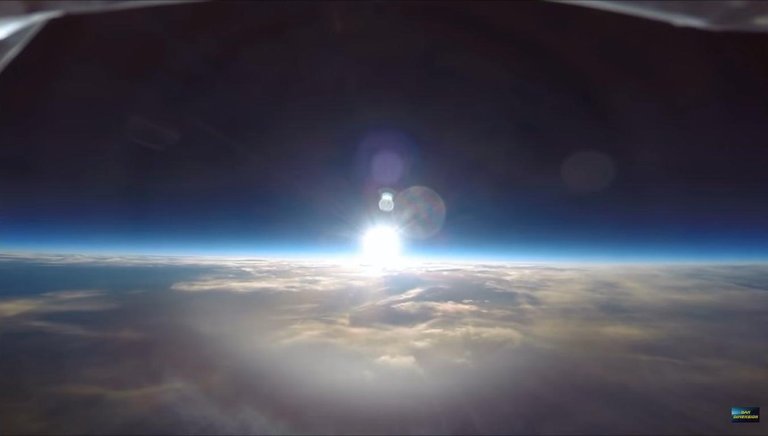
In the late 19th century, mostly thanks to the experiments, books, and lectures of an English inventor and author named Dr. Samuel Rowbotham, a flat Earth renaissance began sweeping the world. Rowbotham’s findings, beginning with his 1864 book, “Earth Not a Globe! An Experimental Inquiry into the True Figure of the Earth: Proving it a Plane, Without Axial or Orbital Motion; and the Only Material World in the Universe,” caused quite a stir in the scientific community and thanks to three decades of his efforts, the shape of the Earth became a hot topic of debate around the turn of the 19th century. Dr. Rowbotham conducted several experiments using telescopes, spirit levels, and theodolites, special precision instruments used for measuring angles in horizontal or vertical planes. By positioning them at equal heights aimed at each other successively he proved over and over the Earth to be perfectly flat for miles without a single inch of curvature.
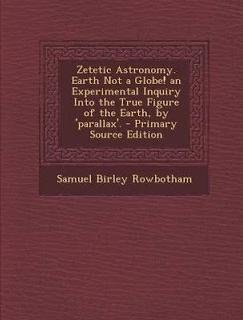
In his most famous series of experiments, Rowbotham traveled to Cambridge, England where there is a 20 mile canal called the Old Bedford which passes in a straight line through the Fenlands known as the Bedford Level. The water has no interruption from locks or water-gates of any kind and remains stationary making it perfectly suitable for determining whether any amount of convexity/curvature actually exists. If we were living on a ball-Earth, every pond, lake, marsh, canal and other large body of standing water, each part would have to comprise a slight arc or semi-circle curving downwards from the central summit. If the ball-Earth were truly 25,000 miles in circumference as claimed by heliocentrists, then spherical trigonometry dictates the surface of all standing water must curve downwards an easily measurable 8 inches per mile multiplied by the square of the distance. This means along a 6 mile channel of standing water the Earth would have to curve 16 feet, 8 inches downwards from one end to the other, and/or dip 6 feet on either end from the central peak, depending where the measurement is taken.
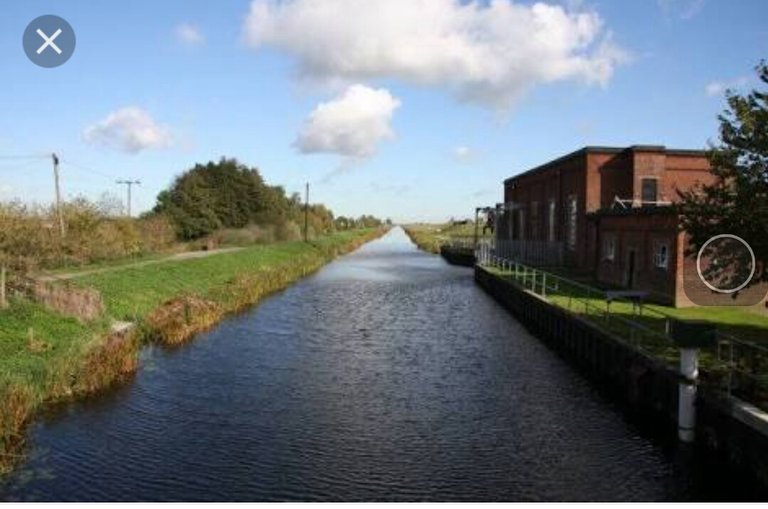
Rowbotham tested first by standing in the water holding a telescope 8 inches above the surface, while his partner rowed away from him in a small boat with a 5 foot tall flag attached. If the Earth was indeed a globe 25,000 miles in circumference, by the time the boat reached Welney Bridge 6 miles away, the entire boat and flag should have been completely invisible hidden behind a 6 foot tall mass of curved water. In reality however, every time tested, the entire boat and flag remained visible from start to finish. In a second experiment Dr. Rowbotham placed seven flags along the edge of the water each one mile distant from the next with their tops positioned 5 feet above the surface and stood with his telescope behind the first. If the Earth was a globe 25,000 miles in circumference, each successive flag would have to decline a definite and determined amount below the last. The first and second flags establish the line of sight, then the third should fall 8 inches below the second, the fourth flag 32 inches below, the fifth 6 feet, the sixth 10 feet 8 inches, and the seventh flag should be a clear 16 feet 8 inches below the line of sight! Even if the Earth was a globe of a hundred thousand miles, an amount of easily measurable curvature should and would still be evident in this experiment. But the reality is not a single inch of curvature was detected and the flags all lined up perfectly as consistent with a flat plane.
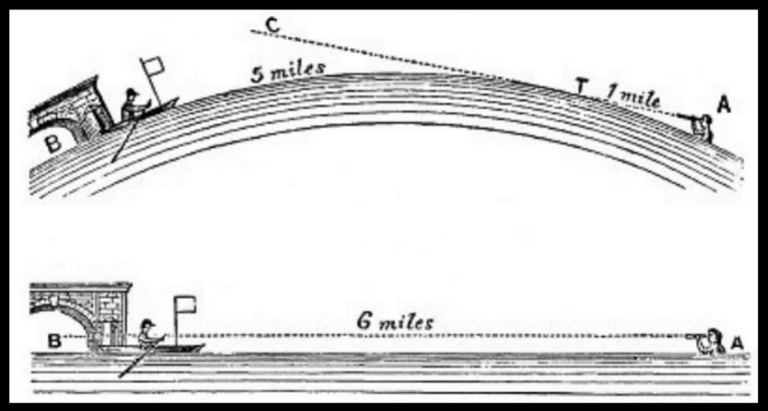
In 1870 one of Rowbotham’s supporters, an English scientist of the Royal Academy named John Hampden, offered a public wager of 500 pounds to anyone who thought they could prove the Earth spherical by repeating the Bedford Level experiment. Alfred Russell Wallace, a fellow English scientist, ardent evolutionist and personal friend of Charles Darwin, accepted Hampden’s wager and the two met with referees to decide the matter at the Bedford Level. The original plan was to repeat Rowbotham’s flag experiment, but after hours of attempting to align them one on each mile marker, upon looking through the telescope “they could not even judge which was which, let alone decide whether the line of sight along them was flat or curved. Heated debate ensued, an angry quarrel followed, and the experiment descended into a farce.” They called it a day, but a week later reconvened, this time Wallace setting new perimeters for the experiment which had never been tested or approved by Rowbotham or Hampden.
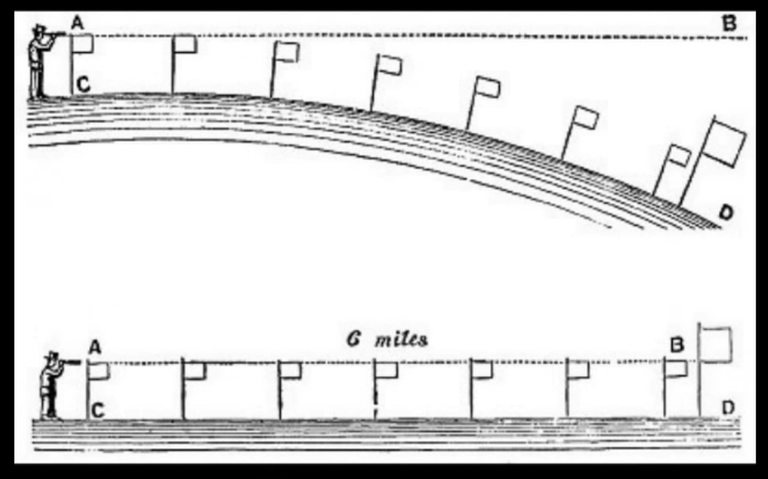
Wallace hung a large calico sheet from the Old Bedford Bridge with a thick black line painted across its center and positioned his telescope six miles south at Welney Bridge at the same elevation. Then halfway between these two points, Wallace placed a long red pole topped with a marker disc designed to fall in line with the black painted marker and telescope. All of these he placed at a Masonically significant 13 feet 3 inches above the water. Wallace’s plan was to view the marker disc and black line through the telescope, and if the middle marker appeared below the line of sight, this would be taken as proof of the water’s flat surface, and if the middle marker appeared above the line of sight it would be taken as proof of Earth’s curvature. Hampden immediately took issue with this new method of allegedly determining curvature but begrudgingly accepted to continue. When viewed through the telescope, the center marker fell a tiny bit below the telescope cross-hair, and the far marker on the bridge fell a tiny bit below that. This result was not expected by either party, but Wallace quickly claimed it proof that Earth was curving downwards, while Hampden claimed the results to be in accordance with the law of perspective over flat surfaces. This time an even more heated debate ensued until Wallace refused to speak another word with Hampden, gave him the silent-treatment, and even had the police escort Hampden him from his hotel room before leaving town the following day.
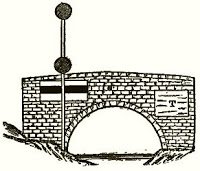
The referees for the wager decided in favor of Wallace and the money was given to him. In response, Hampden immediately published a 16-page pamphlet denouncing Wallace as a liar and cheat called, “Is Water Level or Convex After All? The Bedford Canal Swindle Detected and Exposed.” Another fellow English author and flat-Earther, William Carpenter, also present during the experiment, wrote his equally scathing 30-page review of the swindle entitled, “Water Not Convex, The Earth Not a Globe! Demonstrated by Alfred Russel Wallace on the 5th March 1870” Hampden later took Wallace to trial and sued him for his 500 pounds. The court formally decided in favor of Hampden that the bet was invalid and returned his money in full.
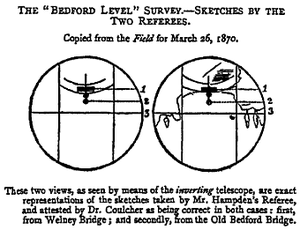
Next Hampden immediately re-issued his challenge to Wallace, increasing the wager to 1000 pounds and inviting Dr. Rowbotham to attend. This time the experiment would be conducted as Rowbotham had originally done, standing in the water with telescope held 8 inches above the water observing a boat with a 5 foot flag attached sailing 6 miles away from Welche’s Dam to Welney Bridge. When the day of the wager came, poor weather prevented them from completing the experiment so they postponed, met more bad weather, and postponed again. On their third and final attempt before heading home with the weather still overcast they attempted the experiment. Unfortunately shortly after reaching the half-way point the boat became indistinguishable beyond the haze and the bet was called off. The boat and flag were visible, however, for the entire 3 miles. In 2015 a group of flat-Earthers once again repeated Rowbotham’s experiment at the Bedford Level with similar results. They detected no curvature and saw the boat beyond the half-way marker, but became obscured by poor weather before reaching the full 6 miles.
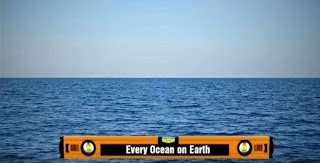
Till now, from what we have witnessed, there could not be found any detectable curvature of the Earth.
From previous articles we learned that no motion of the Earth could be detected.
Hmmm, something is fishy here... someone is not telling us the truth, instead only lies.
Stay tuned and we shall continue examining, testing, reasoning and using common sens to understand better where we live, why we are here, who put us here and for what purpose.
Thank you and all the best!
Source: http://www.ericdubay.com/